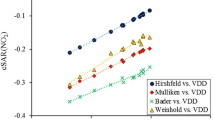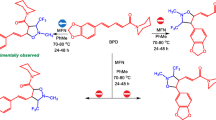Abstract
The energies and oscillator strengths of the singlet-singlet transitions for thesyn- andanti-ring [2.2]quinolinophanes—regarded as quinoline dimers—were calculated usingPPP CI-1 method and compared with experimental spectra. The theoretical transitions were assigned to the observed broad bands and characterised in terms of locally excited and charge transfer contributions. The influence of the pseudosubstituent effect is also discussed.
Zusammenfassung
Die Anregungsenergie und Stärke des Oszillators vom Typ „singlet-singlet” fürsyn- undanti-Ring [2.2]Quinolinophanen, betrachtet als Quinolinodimere, wurde mit dem Ultraviolett-Spektrum verglichen und nach derPPP-CI-1-Methode berechnet. Den beobachteten breiten Banden wurde die theoretische Übergangsenergie zugeordnet. Die Übergänge wurden nach ihrem Anteil an „lokalem Anregungscharakter” (LE) und dem Ausmaß der Ladungsübertragung (CT) klassifiziert. Der Anteil des Pseudosubstituenteffekts wird diskutiert.
Similar content being viewed by others
References
Maślankiewicz, M. J., Czuchajowski, L., Bull. Acad. Polon. Sci., ser. sci. chim.27, 167 (1979).
Ibid (in print).
Beveridge D. L., Hinze, J., J. Amer. Chem. Soc.93, 3107 (1971).
Iwata S., Fuke K., Sasaki M., Nagakura S., Otsubo T., Misumi S., J. Mol. Spectr.46, 1 (1973).
Czuchajowski L., Pietrzycki W., J. Mol. Struct.47, 423 (1978).
Witkowski A., in: Modern Quantum Chemistry, Istanbul Lectures, Vol.3, p. 161. Academic Press 1965.
McGlynn S. P., Dougherty D., Mathers T., Abdulner S., Jerusalem Symp. Quantum Chem., Biochem., Vol. 10, 247 (1977).
Kwiatkowski J. S., private communication.
Tables of Interatomic Distances and Configuration of Molecules and Ions, Chem. Soc. Special Publ. No. 18, p. 120. London. 1965.
Toyoda T., Misumi S., Tetrahedron Lett.1978, 1479.
Nishimoto K., Nakatsukasa, K., Fujishiro R., Kato S., Theor. Chim. Acta14, 80 (1969).
Iwama A., Toyoda T., Yoshida M., Otsubo T., Sakata Y., Misumi A., Bull. Chem. Soc. Japan51, 2988 (1978).
UV Atlas of Organic Compounds (DMS), Vol. I. London: Butterworth; Weinheim: Verlag Chemie.
Author information
Authors and Affiliations
Rights and permissions
About this article
Cite this article
Czuchajowski, L., Wisor, A.K. & Maślankiewicz, M.J. Electronic spectra ofsyn- andanti-ring [2.2]quinolinophanes. Monatshefte für Chemie 112, 1175–1185 (1981). https://doi.org/10.1007/BF00905472
Received:
Accepted:
Issue Date:
DOI: https://doi.org/10.1007/BF00905472




